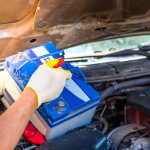Are you an avid road warrior, constantly seeking new adventures on the open highway? If so, you probably know that the journey is just as important as the destination. For Ford F250 owners, long-haul drives can be both exhilarating and challenging, especially when it comes to fuel capacity. Running low on gas can cut a trip short, leaving you stranded and scrambling for a refill. That’s where a fuel tank upgrade comes in!
In this article, we will explore the benefits of upgrading the fuel tank on your Ford F250, revealing how you can boost your vehicle’s capacity, extend your range, and enhance your overall driving experience. Whether you’re towing heavy loads, embarking on a cross-country journey, or simply seeking peace of mind on lengthy drives, this guide will provide you with valuable insights and practical tips to help you make the most of your F250. So, buckle up and get ready to fuel your adventures!
Table of Contents
- Understanding the Benefits of Upgrading Your Ford F250 Fuel Tank
- Choosing the Right Fuel Tank Options for Enhanced Capacity
- Step-by-Step Guide to Installing Your New Fuel Tank
- Maintenance Tips for Ensuring Longevity and Performance
- Q&A
- The Way Forward

Understanding the Benefits of Upgrading Your Ford F250 Fuel Tank
Upgrading your Ford F250 fuel tank is a decision that can significantly enhance your driving experience, especially for those who frequently tackle long-haul drives. One of the primary benefits of a larger fuel tank is the increased capacity it offers. This means fewer stops at the gas station, allowing you to cover more ground in a single journey. Imagine how much time you can save on a road trip when you can go the extra mile without the constant interruptions of refueling. Additionally, a larger tank can provide peace of mind, knowing that you have a greater range, which is particularly useful in remote areas where gas stations are scarce.
Moreover, upgrading your fuel tank can also contribute to improved efficiency and performance. With a bigger tank, you can take advantage of bulk fuel purchasing, often leading to cost savings per gallon. Additionally, the weight distribution can change with a new tank, which can affect your truck’s handling and stability positively. Features of modern aftermarket tanks can include enhanced materials that resist corrosion and better fitment options tailored to your specific needs. Consider the following advantages when pondering a fuel tank upgrade:
- Reduced fuel runs: Spend more time on the road.
- Enhanced range: Drive further without worry.
- Cost efficiency: Potential savings on fuel costs.
- Improved weight distribution: Better handling on all terrains.
Choosing the Right Fuel Tank Options for Enhanced Capacity
When it comes to upgrading your Ford F250’s fuel tank, considering the variety of options available is essential for maximizing your vehicle’s capacity. You want to choose a tank that not only offers increased volume but also aligns with your driving habits and requirements. Look for tanks that are constructed from durable materials such as high-density polyethylene or aluminum, providing both strength and longevity. Additionally, an expanded tank size can lead to better fuel efficiency for those long-haul drives, reducing the number of stops you need to make, thus saving time and enhancing your overall driving experience.
In selecting the right tank, consider the following features to ensure you make a well-informed choice:
- Compatibility: Ensure the tank fits your specific Ford F250 model year.
- Installation: Look for options that offer straightforward installation or hire a professional if necessary.
- Capacity Increase: Determine how much additional fuel capacity you need based on your typical driving distances.
- Weight Distribution: Ensure that the tank doesn’t negatively impact the vehicle’s handling.
Here’s a quick comparison table to help you visualize your options:
| Tank Type | Material | Capacity (Gallons) |
|---|---|---|
| Standard Replacement | Steel | 34 |
| Extended Range | Polyethylene | 50 |
| Custom High-Capacity | Aluminum | 60 |
Step-by-Step Guide to Installing Your New Fuel Tank
Once the old tank is out, prepare to install your new tank by checking for compatibility and ensuring it fits snugly in place. Attach the new fuel lines and make sure all connections are secure. It’s advisable to replace any filters or seals during this process to prevent future leaks. After everything is in place, lower the vehicle and reconnect the battery. Performing a quick leak test by turning the ignition to the “on” position without starting the engine is a wise precaution. If all looks good, start the engine and let it run for a few moments to ensure everything is functioning correctly.

Maintenance Tips for Ensuring Longevity and Performance
To keep your upgraded Ford F250 fuel tank functioning optimally, regular maintenance is essential. Here are some simple yet effective practices:
- Inspect for Leaks: Regularly check for any signs of leaks or corrosion around the fuel tank and its connections. Early detection can save you from more significant issues down the line.
- Fuel Quality: Use high-quality fuel to prevent sediment build-up and engine complications. Avoid filling up at stations with questionable refineries.
- Periodic Cleaning: Clean the fuel system components, including the fuel filter, to ensure efficient flow and performance. Schedule this as part of your routine maintenance.
In addition to these practices, monitoring your fuel gauge and overall fuel efficiency can help catch potential problems early. Consider these tips to maintain peak performance:
- Monitor Mileage: Keep track of your miles per gallon to notice any significant drops that may indicate issues.
- Check Fuel Lines: Inspect fuel lines for any cracks or wear and replace them as needed to prevent leaks.
- Fuel Additives: Utilize fuel additives occasionally to keep your fuel system clean and improve combustion.
Q&A
Q&A:
Q1: What is the main benefit of upgrading the fuel tank on a Ford F250?
A1: Upgrading the fuel tank on your Ford F250 significantly increases its fuel capacity, allowing for longer driving ranges between fill-ups. This is especially beneficial for long-haul drives or when towing heavy loads, as it reduces the need for frequent stops at gas stations.
Q2: How much additional fuel capacity can I expect from an upgraded tank?
A2: Depending on the specific upgrade, you can typically expect an increase of anywhere from 10 to 30 gallons of fuel capacity. This varies based on the model year of the F250 and the type of aftermarket tank selected.
Q3: Are there different types of fuel tanks available for the F250?
A3: Yes, there are several types of aftermarket fuel tanks available for the Ford F250. These include auxiliary tanks that can be added alongside the factory tank, larger replacement tanks that replace the factory unit entirely, and custom options designed for specific needs. Always ensure that the chosen tank is compatible with your truck’s year and model.
Q4: Will upgrading my fuel tank affect my vehicle’s performance?
A4: Generally, upgrading the fuel tank should not negatively affect your truck’s performance. In fact, having a larger tank can enhance your driving experience by reducing the frequency of stops and allowing for longer uninterrupted trips. Just be sure that the extra weight of a larger tank doesn’t exceed your truck’s payload capacity.
Q5: Is the installation of a new fuel tank complicated?
A5: While fuel tank installation can be a bit complex, it is certainly manageable for those with some mechanical experience. It typically involves lifting the truck, disconnecting the old tank, and replacing it with the new one. However, if you’re not comfortable with this type of work, it’s advisable to seek the help of a professional mechanic.
Q6: Are there any regulations or considerations I should be aware of when upgrading my fuel tank?
A6: When upgrading your fuel tank, it’s important to ensure that the new tank complies with local regulations and safety standards. You should also consider the weight distribution and how it may impact your truck’s handling and braking. Checking with your local Department of Motor Vehicles (DMV) about any necessary permits or inspections can also be helpful.
Q7: How does a larger fuel tank impact fuel efficiency?
A7: A larger fuel tank itself does not directly impact fuel efficiency; however, it does allow you to travel longer distances without refueling, which can be more efficient in terms of travel time. Just remember that increased weight from a full tank may slightly affect your fuel economy, especially when towing heavy loads.
Q8: Can I use my existing fuel lines and fittings with an upgraded tank?
A8: In most cases, yes! Most aftermarket fuel tanks are designed to work with the existing fuel lines and fittings of your Ford F250. However, it’s always best to double-check compatibility and follow the installation instructions provided with the new tank.
Q9: What should I look for in a quality fuel tank upgrade?
A9: When choosing a fuel tank, look for one made from high-quality materials, preferably with corrosion resistance. Check for reviews and testimonials to ensure reliability, and see if it comes with a warranty for added peace of mind. Ensure it’s designed specifically for your F250 model for the best fit and performance.
Q10: How can I maintain my upgraded fuel tank?
A10: To maintain your upgraded fuel tank, regularly inspect it for signs of wear, corrosion, or leaks. Keep the tank clean and ensure that the fuel is free from contaminants. Following the manufacturer’s maintenance guidelines can help prolong the life of your upgraded tank.
The Way Forward
upgrading your Ford F250’s fuel tank is a smart investment for any long-haul driver looking to maximize efficiency and convenience on the road. With increased capacity, you can enjoy extended trips between fuel stops, saving both time and money during your adventures. When considering your options, be sure to prioritize quality and compatibility with your vehicle to ensure a seamless installation and optimal performance. Whether you’re hauling heavy loads or embarking on a cross-country journey, a fuel tank upgrade can significantly enhance your driving experience. Thank you for joining us on this exploration of fuel tank enhancements—here’s to many more miles driven with confidence and ease! Safe travels!











